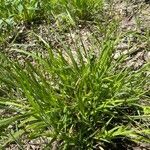Culms densely tufted, central or lateral, rarely erect, ascending, lax, or, occasionally, decumbent, slightly winged, 14–53 cm × 0.8–1 mm. Leaves: basal sheaths brown or light brown; sheaths 1–48 mm; blades erect, ascending or lax, green, midrib well developed abaxially, lateral veins developed adaxially, flat, 14–36 cm × 1–10 mm, blades of overwintering leaves smooth abaxially. Inflorescences: peduncles of proximal absent; of terminal spike 0–1.7 cm. Bracts 0.9–17 cm × 1–8 mm, bract blade of distal lateral spikes linear, narrower than spikes, not concealing them (viewed from abaxial surface), widest bract blade of distalmost lateral spike 0.5–3.4 mm wide. Spikes 4(–5) per culm; lateral spikes scattered or distal 2 proximate, 15–18 × 3–4 mm; terminal spike overtopping or proximate to proximal pistillate spikes, linear, 9–20 × 1.8–2.4 mm. Pistillate scales 2.8–3 × 1.4–1.6 mm, apex apiculate to aristate, awn to 1.5 mm. Staminate scales 1.8–3.2 × 1.4–1.8 mm, margins hyaline, apex acute or acuminate. Anthers 1.8–2.2 mm. Perigynia 4–18 per spike, closely overlapping, ratio of longer lateral spike length to perigynia number 0.8–1.7, aggregated, ascending, conspicuously (22–)25–32-veined, obovate to elliptic-obovate, 2.5–3.8(–4.1) × 1.3–2.2 mm, 1.5–1.9 times as long as achene bodies; beak abruptly bent, 0.2–0.6 mm. Achenes obovoid, 2.1–3.2 × 0.8–1.8 mm. 2n = 30, 32, 34, 36.
More
Tufted, 2–6 dm; fertile stems triangular and slightly winged, minutely serrulate above; basal sheaths ± brown; lvs of the sterile shoots to ca 10 mm wide, those of the fertile ones a little narrower; angles of the bract-sheaths minutely ciliate-serrulate; terminal spike staminate, 1–2 cm, on a short to elongate peduncle, often overtopped by the uppermost bract; pistillate spikes 3–4, 1.5–2 cm, scattered or the upper 2 approximate, none basal; pistillate scales prominently cuspidate or short-awned; perigynia 4–18, crowded and overlapping, greenish or yellowish-green, 2.5–4 mm, finely many-nerved as well as 2-ribbed, obtusely trigonous, obovoid, abruptly contracted to a short, abruptly bent beak with entire orifice; achene obtusely trigonous; 2n=36, 38, 40. Dry to mesic woods, sometimes weedy; Me. and s. Que. to N.D., s. to Ga., nw. Fla., and Tex. (C. amphibola; C. laxiflora var. b.)


